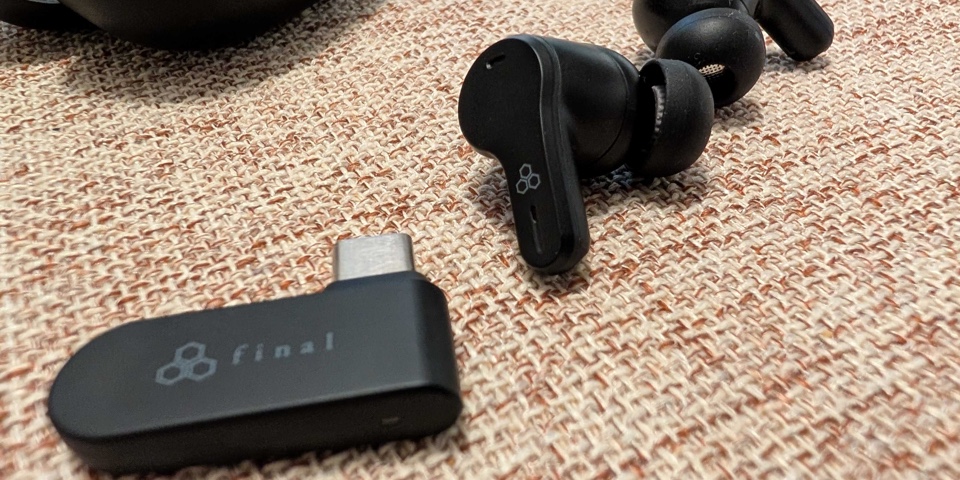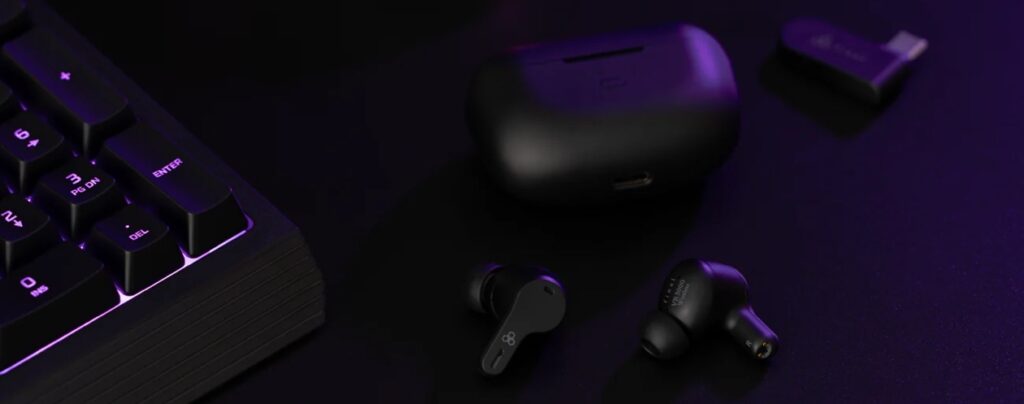Final have a long and storied history in the audio sector. Established in 1974, the Japanese company soon became well-known for their detailed audio, with products from record player cartridges through to speakers and amps. In the present day, Final have retained that penchant for detail, turning their focus to consumer headsets and earbuds. The Final VR3000 Wireless is the latest of those products, a true wireless
The Final VR3000 Wireless is a pair of gaming-focused Bluetooth and 2.4Ghz wireless-equipped earbuds, with our review unit arriving in an understated black. In the pack you get the earbuds, a dinky USB-C low-latency wireless dongle, a curved charging case, a charging cable, and a selection of eartips so you can find the best fit.
The case is relatively small – about the same width as an Airpod Pro case, but thicker thanks to the wider earbuds inside. It’s pleasantly smooth, but it’s definitely lighter and more plasticky feeling than some of those you’ll experience with more premium earbuds. In terms of controls, there’s a single pairing button on the front, and four LEDs to show charging state and connection to the earbuds, while charging comes via the USB-C port at the bottom.
The earbuds boast a very good 11 hours of charge, with the case extending that by 38 hours, and they can both go from empty to full in two hours. The VR3000 Wireless have been great for a few recent trips, lasting through all of my Switch 2 gaming while on the go, and the few times I’ve had to charge they’ve topped up super-fast. They’re definitely easy to live with.
The low-latency USB-C transmitter is nice and small, so whether you’re using the top or bottom USB-C sockets on Switch 2 – or any other device, including mobile – it’s small enough to stay out of the way, and doesn’t look too odd or out of place. My one fear is that there’s no place for this in the charging case, and it feels as though it’s something that I’m going to lose sooner or later, or a feature that’s best kept at home.
The earbuds themselves take some design cues from Apple’s Airpods, with a short arm extending down from the body of the earbud, though the touch controls are on the main surface of the earbud instead of the stem. They have a larger central body though, and that undoubtedly helps the VR3000’s bass response. It doesn’t make them the slimmest or sleekest buds though, and I found they stick out just that little more than some earbuds out there. They’re made from relatively light black plastic though, and the low weight means that they don’t start to wear on you through longer listening or gaming sessions.

The Final VR3000 wireless sound excellent, especially for gaming. The use of the USB-C 2.4Ghz transmitter certainly improves the audio quality, but there isn’t a gulf of difference between wireless and Bluetooth that you might find elsewhere. The bass response is powerful and enveloping, making it ideal for high-action titles like Cyberpunk 2077, while it dispenses more thoughtful soundtracks like those found in Tales of Shire or Story of Seasons: Grand Bazaar with careful nuance.
There is a little more mid in the mix than I’d often look for, particularly when listening to music, but it helps to lift vocals and dialogue from the other instrumentation or audio details. I did find that music listening benefited from some EQ tweaking, but Bad Omen’s Concrete Jungle sounded excellent, with powerful guitars grinding away while the soaring vocals showcase the separation that the VR3000 are capable of.
The VR3000 Wireless have clearly been tuned for gaming and content though. I’ve been consistently surprised by just how good they sound, and their form factor has made them an ideal choice for handheld and mobile gaming. I’ve been playing a lot of Wild Hearts S, and the monster-hunting action sounded brilliant with the VR3000, especially the Eastern-influenced orchestral soundtrack.
That’s helped by the hybrid ANC. The noise cancellation is clearly a step below what you’ll find in Apple’s AirPods Pro or Sony’s XM5 earbuds, but it does a decent job of erasing sounds like fan noise from your PC, Steam Deck or Switch 2, or cutting down on low-level train and plane background sound. The lighter effect does mean that no discernible pressure or audio alteration is happening, and if you’re playing competitively, that’s going to help you stay focused and on point. At this price point, it’s a welcome inclusion, even if it isn’t the strongest version I’ve ever experienced.
Final have their own Android and iOS app as well, though it is distinctly bare bones. It does, however, let you adjust the EQ settings, with a batch of presets, and there’s the option to customise the sound setup as well, which is essential. Besides that, you can turn the ANC on and off, or set it to Ambient, and update the earbuds’ firmware. It is all very clear and easy to operate, but it would have been nice to delve into the earbuds’ setup a little further.
At £129.99, the Final VR3000 sit in the mid-range price point for earbuds. If you’re gaming, the USB-C dongle offers a clear advantage over Bluetooth-only options, both in terms of latency and reliable connection. If you have a Switch 2 or a Steam Deck, that recommendation is even higher as the dongle pops into the top USB-C port. If you’re planning on listening to a lot of music though, the Hecate GX05 are the better option, offering Hi-Res audio, and a place to store the USB-C dongle, though the huge, heavy, screen-scratching metal case will be a distinctly bigger statement than the VR3000’s understated option. If you find you have more money in your pocket, there’s also the SteelSeries Arctis GameBuds which have a lot of the same features, but improve on some of the VR3000’s core features such as ANC, while including having a space in the case for the dongle.

